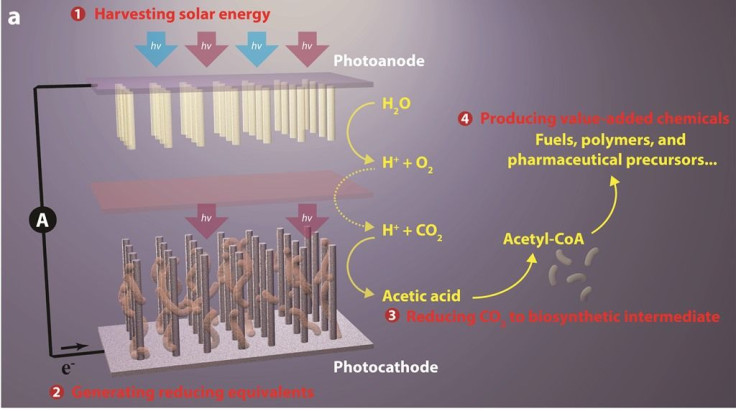Artificial Photosynthesis System Created From A Nanowire-Bacteria Hybrid
In a move that could potentially herald an era of clean, sustainable energy, scientists at the U.S. Department of Energy’s Lawrence Berkeley National Laboratory and the University of California, Berkeley, have developed a nanosystem that successfully mimics the natural process of photosynthesis. However, unlike natural photosynthesis, wherein carbon dioxide and water are used to synthesize carbohydrates in the presence of sunlight, this artificial system synthesizes acetates -- the most common building blocks for biosynthesis that can eventually be used to produce drugs and biofuels.
“We believe our system is a revolutionary leap forward in the field of artificial photosynthesis,” Peidong Yang, a chemist with the lab’s Materials Sciences Division and one of the authors of the study, published in the journal Nano Letters, said, in a statement. “Our system has the potential to fundamentally change the chemical and oil industry in that we can produce chemicals and fuels in a totally renewable way, rather than extracting them from deep below the ground.”
The technique developed by the Berkeley researchers utilizes an “artificial forest” of silicon and titanium oxide nanowires, which function much like chloroplasts in green leaves. The anaerobic bacteria -- Sporomusa ovate -- are buried in these tall nanowire structures like “Easter eggs buried in tall grass.”
When sunlight is absorbed by these semiconducting nanowires, electrons and electron holes are generated. The electrons are passed to the bacteria for carbon dioxide reduction, resulting in the production of a biosynthetic intermediate, while the holes split water molecules to produce oxygen.

“Once the carbon dioxide has been reduced by S. ovata to acetate (or some other biosynthetic intermediate), genetically engineered E.coli are used to synthesize targeted chemical products,” the researchers said, in the statement.
Although the solar energy conversion efficiency, which measures the proportion of incipient solar radiation converted into useful energy of this hybrid structure is currently 0.38 percent, scientists are working toward improving this to 10 percent.
“Once we can reach a conversion efficiency of 10-percent in a cost effective manner, the technology should be commercially viable,” Yang said, in the statement.
© Copyright IBTimes 2025. All rights reserved.




















